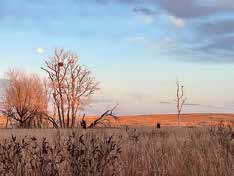
- Chris Pascone
- From Whitetales
- Hits: 1643
Preserving Habitat to Protect the Hunt
- Chris Pascone
- From Whitetales
- Hits: 1643
Mark Anderson hunts from a heated deer stand mounted on a Chevy truck bed on his property outside Sauk Centre these days. “I’ve paid my dues freezing in ladder stands,” says the 84-year-old. Like in 1982, when he shot a non-typical 18-point buck. “It weighed 190 lbs. dressed. We made a gun rack out of the hooves. Today it has my dad’s old Zulu 12-gauge shotgun hanging on it.” Moments like these, hunting with his son-in-law while his wife and daughters bake Christmas cookies back at the house, keep Anderson coming back for more.
Deer hunting is a timeless pursuit for Anderson, and his property has a timeless quality about it too. That’s because his family’s property is forever protected through a conservation easement with the Minnesota Land Trust.
Anderson is not alone; many landowners have achieved their dream of protecting their properties from future development with a conservation easement. Knowing the property will provide wildlife habitat and leave a legacy for the next generation is a driver for many.
How does a conservation easement work? The landowner gives up certain future land use options—like sub-development of the property—to protect its conservation value. The conservation easement is a permanent, legal document that transfers with the land to any future owners, providing peace of mind that your land is protected forever.

Paul Standafer, Jesse Johnson, and Mike Sieve are three other Minnesotans who, like Anderson, have long-standing hunting traditions on their properties. Though they don’t know one another, they’re all united by a common bond – they’ve all placed conservation easements on their land in recent years.
For Jesse Johnson, whose property is within the heavily developed St. Cloud/I-94 area, deciding to permanently protect his property was about sharing the land with his hunting partners, wife, and even the public. “I have a house here, and my friends pull their fish houses up to the property. We basically turn it into a camping experience. Cook dinners. Skid out our gear, talk about our hunt. My wife and I like nature, and our property is right next to a lake that we frequent. We’ve planted native grasses that filter out runoff going into the lake. We like people being able to see nature that they don’t see every day.”

Jesse says he and his wife think about what the property looked like before settlers from Europe arrived and began changing the landscape. “What was it supposed to look like, essentially, three or four hundred years ago?” they ask.
Thanks to their conservation easement, the Johnsons’ land will remain in its natural state three hundred years into the future too. The Johnsons committed to protecting this ideal deer habitat with a mix of grassland, woods, and wetlands, along with two natural springs and a stream. For Jesse, “it’s nice to know your property will never be developed, ever.”
Paul Standafer, who owns hunting land together with two partners on the Little Rock River in far southwestern Minnesota, was focused on passing down hunting heritage to the next generations when he protected his land two years ago. “When I bought the property thirty years ago, I wasn’t thinking about passing it on to the kids. I was fairly young. But as time marches on, and it becomes obvious that it’s going to become harder to find places to hunt, it became important to me to do the right thing for this land and tie it up.”
The next generation can choose to sell the land, of course. But the conservation easement doesn’t go away. “After I pass away, and the kids own the property, who’s to say they won’t sell it anyway?” recognizes Standafer. “But even if they do sell it, at least it’s going to stay protected, and can’t be farmed. If they sell it, it will be to somebody who has the same goals as I did, which was to have it for recreation.” This dedication to conservation values shines through on private properties throughout the state.
Standafer teaches hunting to his children and grandchildren on his protected property, including ethical harvest. “We could fill our tags every year,” Paul recounts, “but we don’t. If it’s not a decent buck, we’re not going to take it. The kids, on their first hunt or two, can harvest whatever they want, and I’m fine with it. But myself and my adult kids, we’re not going to take anything but a mature buck.” Standafer’s respect for the land, and the animals that inhabit this property, will last forever thanks to his conservation easement.
Legacy and habitat protection are just two of the many factors influencing people’s conservation decisions. Michael Sieve is a professional landscape and wildlife painter. He has a fond affection for his 180-acre farm on Daley Creek (a designated trout stream) in the Driftless Area of southeast Minnesota. Sieve also recently completed his conservation easement. His X-factor? Communion with nature and inspiration for his art.

“It’s one of my favorite places because it’s so unique,” says Sieve of his creek valley, prairie, and woodland. “For me it would have been a shame to develop it. I always knew I didn’t want to see this particular property get developed in some way. Just by nature of the land.”
Sieve takes daily walks on the property (he’s got four miles of trails), and soaks up the environment, which he then interprets in his paintings. Of course, Mike’s a hunter too (see his story “My Best Year” on page 32 in the “Whitetales” winter 2023 issue). Mike’s personal best on his own property is a 179 5/8 buck taken in 2010.
Perhaps Mike’s greatest satisfaction of all has been restoring the natural environment on his land. “When I bought the farm, it was all cow pasture, cropland, and recently logged woods. Many areas looked like a tornado zone, but it's beautiful now,” explains Mike, who plants hundreds of trees a year. “I don’t put in just income-producing trees, like oak, or walnut. I put in red cedars, dogwoods, and whatever the particular habitat calls for.” And in some cases, the Minnesota Land Trust can help with habitat management and restoration, as well as other challenges that come up.
Paul Standafer lauds the conservation easement program at the Minnesota Land Trust: “I think it’s an outstanding program. I can highly recommend it to anyone who’s got some property to make sure it stays in a conservation state. I’ve had nothing but positive experiences working with the Land Trust. If I need something, I call them, and they’ll do whatever they can to help me.”
Jesse Johnson concurs. “The Land Trust continues to help you improve the land even after conservation. They give you ideas. If you’re envisioning a property, what would you want it to look like? They help you reach those goals.”
Mark, Paul, Jesse, and Mike are creating ever-better hunting grounds for themselves, their families, and friends, and they’ve got the results every fall to prove it. They’re harvesting deer, while simultaneously creating better habitat and wildlife viewing, greater generational continuity, and an even deeper connection to every hunt. At the same time, they‘re demonstrating their respect for nature by protecting it forever. Ethical hunting and land stewardship go hand-in-hand, and a conservation easement is the final step to ensuring good deer habitat is protected in perpetuity.
|
Sound good? For more information about permanently protecting your land, contact the Minnesota Land Trust at 651-647-9590 or by visiting mnland.org/hunt. |
|
|
|
Conservation easements referenced in this article were made possible with funding from Minnesota’s Outdoor Heritage Fund, as appropriated by the Minnesota State Legislature and recommended by the Lessard-Sams Outdoor Heritage Council (LSOHC). |
About the Minnesota Land Trust
The Minnesota Land Trust is a conservation non-profit organization based in Saint Paul, Minnesota, that works with private landowners to conserve land through voluntary land protection agreements. The Land Trust’s mission is to protect Minnesota’s most vital natural lands to provide wildlife habitat, clean water, outdoor experiences, and scenic beauty for generations to come.
Since 1991, the Land Trust has partnered with hundreds of Minnesota landowners to permanently protect over 82,000 acres of natural land and 522 miles of fragile shoreline throughout the state. Learn more at mnland.org.











